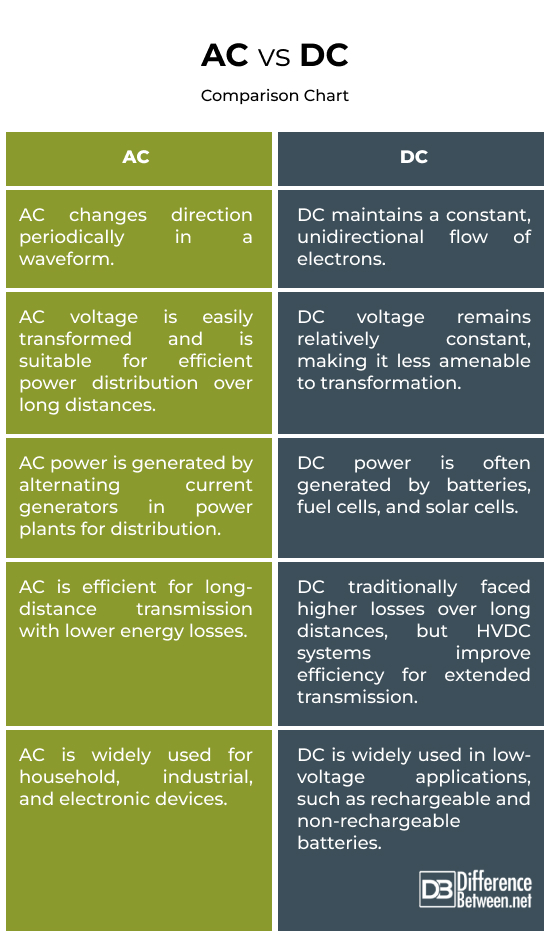Difference Between AC and DC
We all know that electric current flows in two ways: alternating current (AC) and direct current (DC). AC exhibits a dynamic nature, oscillating back and forth, akin to the rhythmic beat of a pendulum. In contrast, DC maintains a steadfast, unidirectional flow, resembling the steady stream of a river. In this article, we delve deeper into the difference between AC and DC current.

What is AC?
Alternating current (AC) is a type of electrical current where the direction of the flow of electrons changes periodically. It alternates between positive and negative cycles, creating a sinusoidal waveform. AC is the predominant form of electrical power used in homes and businesses because it can be easily transformed to different voltage levels. It can travel long distances with minimal loss of energy.

What is DC?
Direct current (DC) means constant polarity and is a constant flow of electric charge in one direction. In a DC circuit, electrons move steadily in one direction from the negative to the positive terminal of a voltage source. It maintains a steady voltage level without reversing its direction. DC power is commonly associated with batteries and electronic devices. Additionally, many vehicles, including cars and certain types of trains, rely on DC power systems.
Difference between AC and DC
Direction of Current Flow
In AC, the flow of electric charge constantly changes direction. It oscillates back and forth, creating a waveform typically represented as a sine wave.
DC, on the other hand, maintains a constant and unidirectional flow of electric charge. The electrons move steadily from the negative to the positive terminal of the voltage source.
Voltage Level
AC voltage levels are easily transformed using devices like transformers. This ability for efficient voltage transformation is one of the reasons AC is commonly used for long-distance power transmission and distribution.
DC voltage remains relatively constant, making it less amenable to easy transformation. DC systems are often associated with fixed voltage sources like batteries.
Generation and Source
AC power is commonly generated by alternating current generators in power plants. These generators produce AC electricity, which is then distributed to consumers.
DC power is often generated by batteries and fuel cells, where chemical reactions produce a continuous flow of electrons. Solar cells also generate DC power, which is converted to AC for use in homes and businesses.
Applications
AC power is widely used for household and industrial applications. It is the primary form of electricity delivered to homes, businesses, and most electronic devices. AC is preferred for its ability to travel over long distances with minimal loss of energy.
DC finds its niche in applications where a constant and steady flow of electricity is required. It is commonly used in batteries to power portable electronic devices, such as smartphones, laptops, and flashlights.
Transmission and Losses
AC is well-suited for long-distance transmission and experiences lower energy losses over extended power lines compared to DC. This is primarily due to the ability to easily transform AC voltage levels, allowing for efficient transmission and reduced energy dissipation.
DC, while efficient for short-distance transmission, faces higher energy losses over long power lines. DC power lines typically require additional equipment, such as converters and inverters, to adjust voltage levels and minimize losses.
AC vs. DC: Comparison Chart

Summary
Understanding these differences is crucial in designing electrical systems and choosing the appropriate type of current for various applications. While AC is prevalent in power distribution, DC plays a vital role in the operation of many electronic devices and portable technologies, where efficient long-distance transmission is crucial.
FAQs
Is a house AC or DC?
Houses typically use AC (Alternating Current) for their electrical systems. AC is the standard for power distribution in residential areas due to its efficient long-distance transmission capabilities.
Why would you use DC instead of AC?
DC is preferred where a constant and steady flow of electricity is required, such as in batteries for portable electronic devices. It is also used in specific applications, like some solar power systems and certain types of transportation.
Where is DC current used?
DC current is commonly used in batteries for electronic devices, including smartphones, laptops, and flashlights. It is also utilized in certain types of vehicles, such as electric cars and some trains.
Is an outlet AC or DC?
Outlets in homes are typically AC outlets. The electrical power supplied to homes and businesses is predominantly AC.
Why is DC not used in homes?
DC is not the primary choice for general home power distribution due to challenges in efficiently transmitting DC over long distances.
Is Canada’s electricity AC or DC?
Canada, like most countries, primarily uses AC for its electricity supply. AC is the standard for power distribution in most regions globally.
Is 240V AC or DC?
240V is typically associated with AC. High-voltage systems, including household power, are generally delivered as AC for efficient distribution.
Which is safer, AC or DC?
In general, AC is considered more dangerous at higher voltages due to its ability to cause muscle contractions, while DC may cause continuous muscle contractions but is often considered less likely to induce fibrillation. Overall, both AC and DC can be safe when handled properly.
Do computers run on AC or DC?
Most computers and electronic devices run on DC. However, the power supplied to homes and offices is AC. Computers typically have power supply units (PSUs) that convert AC to DC to provide the necessary power for the internal components.
- Difference Between Caucus and Primary - June 18, 2024
- Difference Between PPO and POS - May 30, 2024
- Difference Between RFID and NFC - May 28, 2024
Search DifferenceBetween.net :
5 Comments
Trackbacks
- Difference Between Current and Voltage | Difference Between
- Difference Between DC and AC Motors | Difference Between | DC vs AC Motors
- Difference Between Resistance and Impedance | Difference Between | Resistance vs Impedance
Leave a Response
References :
[0]Patrick, Dale and Stephen Fardo. Understanding AC Circuits. Elsevier, 1999.
[1]Kapp, Gisbert. Alternating Currents of Electricity: Their Generation, Measurement, Distribution and Application. Creative Media Partners, LLC, 2023.
[2]Arrillaga, J. High Voltage Direct Current Transmission. Institution of Engineering and Technology, 1998.
[3]Image credit: https://www.canva.com/photos/MAFiMN940Uo-blue-ac-voltage-source-symbol-icon-isolated-on-blue-background-alternating-current-symbol-minimalism-concept-3d-render-illustration/
[4]Image credit: https://www.canva.com/photos/MADSgJxpWEw-batteries-direct-current-in-row-dc-battery-/

very NICEEEEEEEEEEEEe
Very NICEEEEEEEEEEEEEEEE